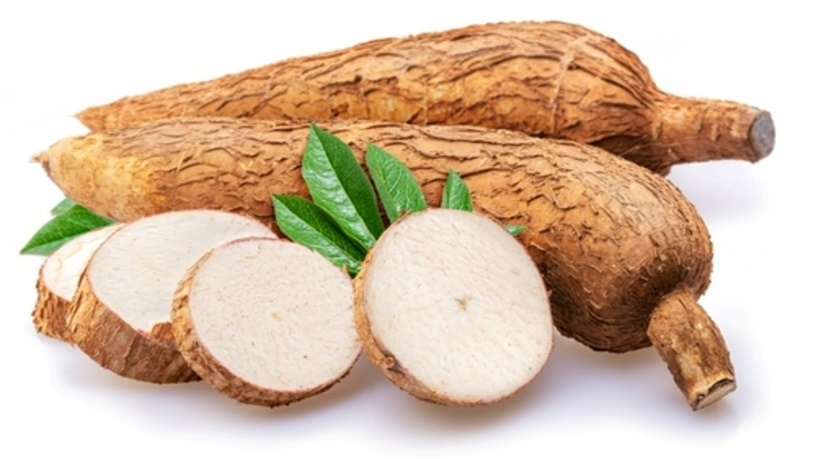Description

Disclaimer: Copyright infringement not intended.
Context
- The ICAR-Central Tuber Crops Research Institute (CTCRI) here has issued an advisory on feeding animals with parts of cassava (tapioca). 13 cows died in Idukki due to peracute cyanide toxicity.
Details
- All parts of cassava/tapioca – leaves, stem, tuber and rind – contain the compounds called cyanogenic glucosides (CNGs), that is, linamarin and lotaustralin (in the ratio 93:7), which are hydrolyzed by endogenous enzyme linamarase to acetone cyanohydrin which may break down spontaneously liberating free hydrogen cyanide. Both acetone cyanohydrin and free cyanide are toxic.
- Cassava leaves contain about 10 times higher amount of CNGs than roots. The CNG content of cassava leaves decreases with the increase in the age of the leaves. The rind contains 10-30 times higher cyanoglucoside content than the edible parts. Feeding crushed peels or leaves immediately after crushing or without proper drying poses a high risk of cyanide poisoning in animals, according to the advisory.
- Tuber/roots of non-bitter cultivars can be fed to the animals after peeling in the raw form. Nevertheless, cooking in water by slowly raising the temperature (tuber pieces should not be put into boiled water) is also advisable.
- Boiling in water (by slowly raising the temperature) or slow sun drying for 12-18 hours can remove up to 80-90% of the cyanoglucosides present in the leaves.
- Since peels contain high amounts of CNGs, it needs to be processed separately to bring down the toxic compounds to safer levels. Crushing the peels and allowing it to remain at room temperature by spreading on a mat for about 5-6 h and then completely drying the crushed peels in sunlight is the best way to remove cyanide.

Cassava Overview:
Introduction:
- Botanical Name: Manihot esculenta
- Common Names: Cassava, yuca, manioc
- Origin: Native to South America
Culinary and Economic Importance:
- Staple Crop: Provides essential carbohydrates globally.
- Versatility: Boiled, fried, baked; gluten-free cassava flour in cooking.
- Economic Impact: Significant export crop, supporting livelihoods of smallholder farmers.
Nutritional Value:
- Energy-Dense: Rich in carbohydrates.
- Nutrient Content: Contains dietary fiber, vitamin C, manganese, and potassium.
Processing and Products:
- Industrial Use: Cassava starch widely utilized in industries.
- Animal Feed: Cassava chips and pellets serve as animal feed.
- Traditional Foods: Products like garri in West Africa are culturally significant.
Agricultural Significance:
- Adaptability: Thrives in tropical climates.
- Drought-Tolerant: Contributes to food security in arid regions.
Challenges and Concerns:
- Cyanogenic Glycosides: Proper processing crucial to mitigate health risks.
- Pests and Diseases: Susceptible, impacting overall yield.

Global Production and Trade:
- Top Producers: Nigeria, Thailand, Indonesia, Brazil, DRC.
- Economic Dynamics: Plays a vital role in international trade and agricultural economies.
Environmental Impact:
- Soil Conservation: Deep roots contribute to soil health.
- Carbon Sequestration: Potential for carbon sequestration, aligning with sustainability goals.
|
PRACTICE QUESTION
Question:
Cassava, a vital crop globally, is known for its adaptability and economic importance. With a special emphasis on health concerns, consider the following statements:
1.Cassava is primarily grown in temperate climates due to its sensitivity to extreme heat.
2.The health risks associated with cassava consumption are primarily linked to the presence of cyanogenic glycosides.
Which of the statements above is/are correct?"
A. Only 1
B. Only 2
C. Both 1 and 2
D. Neither 1 nor 2
Answer: B. Only 2
Explanation:
"Cassava is primarily grown in temperate climates due to its sensitivity to extreme heat." - This statement is incorrect. Cassava is well-suited to tropical climates, not temperate climates.
"The health risks associated with cassava consumption are primarily linked to the presence of cyanogenic glycosides." - This statement is correct. Cassava contains cyanogenic glycosides, and improper processing can lead to the release of cyanide, posing health risks.Top of Form
|











